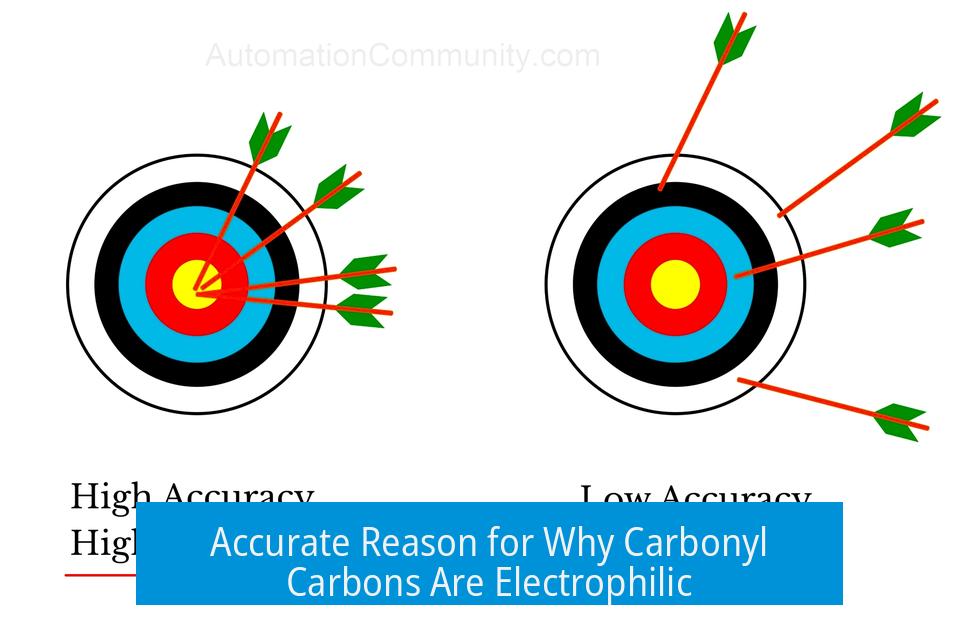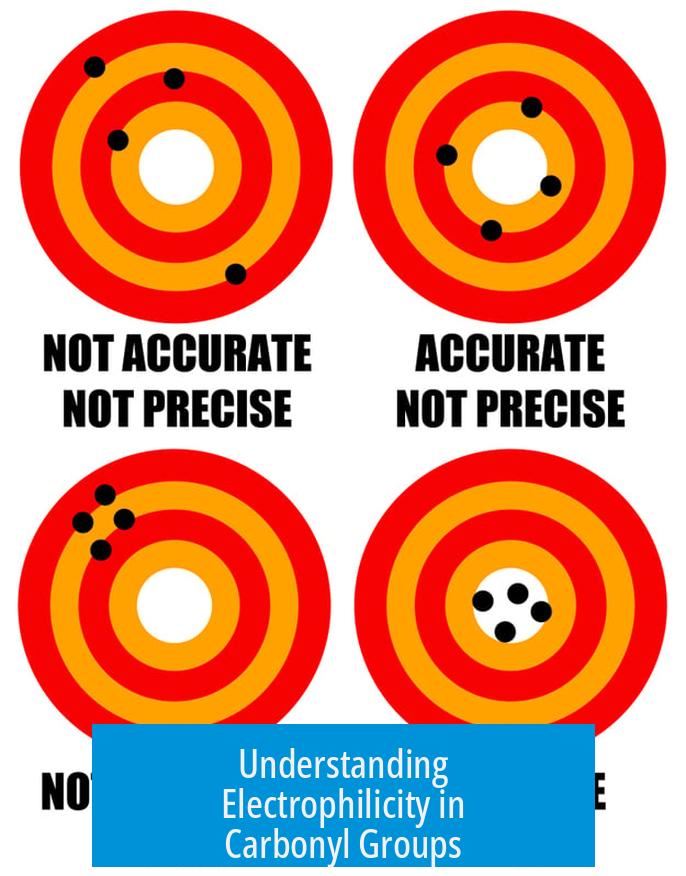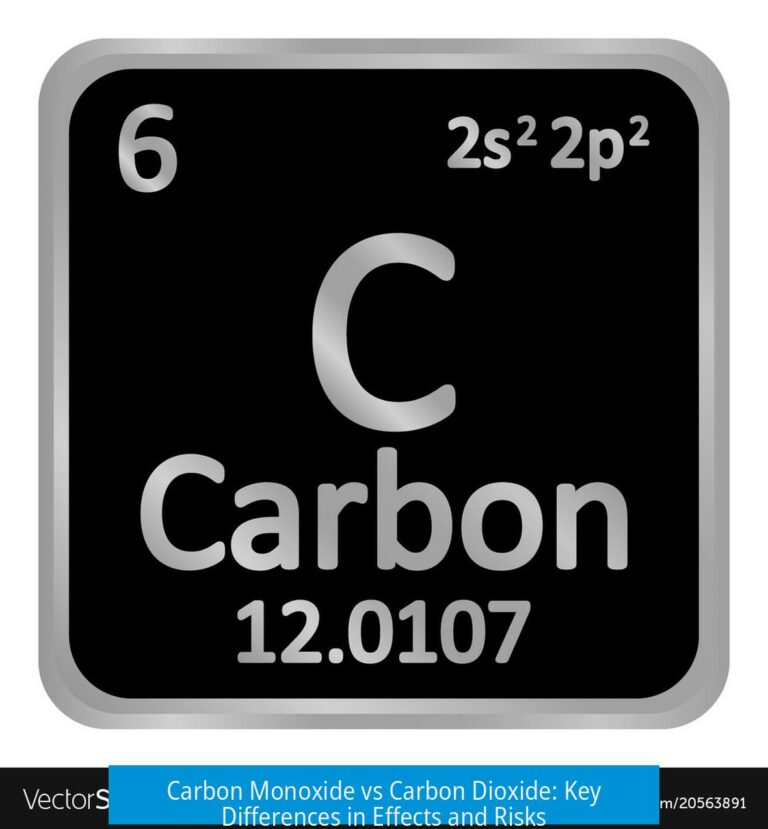Accurate Reason for Why Carbonyl Carbons Are Electrophilic

Carbonyl carbons exhibit electrophilicity primarily because their molecular orbital structure places a larger antibonding (pi*) orbital coefficient on the carbon atom combined with a partial positive charge due to electronegativity differences between carbon and oxygen. This dual effect enhances nucleophile interaction with carbon, making it the favored site for attack in carbonyl compounds.
Understanding Electrophilicity in Carbonyl Groups

The electrophilicity of carbonyl carbons is a fundamental concept in organic chemistry. It explains many reactions involving carbonyl compounds such as aldehydes, ketones, carboxylic acids, esters, and amides. The term “electrophilic” means a region where electron-poor centers attract nucleophiles—species rich in electrons.
Carbonyl compounds have a characteristic C=O double bond, which differs from a simple C=C double bond in electron distribution and reactivity. This difference originates from the unique molecular orbital arrangement and electronegativity differences of the atoms involved.
1. Orbital Coefficient Asymmetry in the Carbonyl Group
The antibonding pi* (pi-star) molecular orbital in carbonyls is asymmetrical compared to those in C=C bonds. Unlike a symmetrical C=C double bond where the pi* orbital coefficients are evenly distributed, a carbonyl’s pi* orbital places a significantly larger orbital coefficient on the carbon atom.
- This asymmetry means the nucleophile’s highest occupied molecular orbital (HOMO) encounters a better match or greater overlap with the carbon’s portion of the lowest unoccupied molecular orbital (LUMO), which is the pi* orbital.
- Better overlap leads to stronger bonding interactions during nucleophilic attack, increasing electrophilicity at the carbon center.
“The pi* orbital in a carbonyl is not symmetrical like a C=C double bond: it’s shifted to place a bigger coefficient on the carbon atom. Nucleophiles have better interactions with bigger coefficients, which makes the atom bearing it more electrophilic.”
2. Partial Positive Charge on Carbon Due to Electronegativity Difference
Oxygen is more electronegative than carbon. This difference pulls bonding electrons toward oxygen, leaving the carbon atom with a partial positive charge (δ+). This charge polarization arises because electrons are unequally shared in the C=O bond.
- The electrostatic attraction makes carbon susceptible to nucleophiles, especially hard nucleophiles that favor charge-based interactions rather than orbital overlap alone.
- This partial positive charge is a driving force for electrophilicity independent of the molecular orbital considerations but complements the orbital effects.
“The partial positive charge on carbon also makes it electrophilic, especially with hard nucleophiles.”
3. Molecular Orbital (MO) Perspective: HOMO and LUMO in Carbonyls
In molecular orbital theory, the HOMO is the highest occupied molecular orbital, and the LUMO is the lowest unoccupied molecular orbital. These orbitals govern chemical reactivity through interactions of nucleophile and electrophile orbitals.
- The HOMO in a carbonyl group is the bonding pi orbital, mainly localized on oxygen due to its high electronegativity.
- Because the HOMO is fully occupied and localized on oxygen, nucleophiles cannot add electrons here.
- The LUMO, the pi* antibonding orbital, is the electrophilic site for nucleophilic attack.
- This pi* orbital features two lobes of opposite phases: a smaller one on oxygen, a larger one on carbon.
- The larger lobe on carbon means nucleophiles overlap best here, attacking carbon rather than oxygen.
“The electrophilic nature of the carbonyl pi bond means it is favourable for a nucleophile to form a bond at the carbon position… the LUMO is a pi* antibonding orbital with two unequal lobes, the larger lobe on carbon, which aligns with the nucleophile’s HOMO.”
4. Relationship Between Electronegativity and Orbital Asymmetry
Electronegativity differences between carbon and oxygen underlie the asymmetry in molecular orbitals and charge distribution.
- Oxygen’s greater electronegativity lowers its atomic orbital energy relative to carbon.
- This energy difference causes the uneven distribution of electron density in molecular orbitals, shifting the pi* orbital weight towards carbon.
- This results in a carbon with lower electron density and a higher energy antibonding lobe that attracts nucleophiles.
“The difference in electronegativity between the two atoms causes the orbital coefficients to shift and is the source of the electrophilicity of carbon.”
5. Conceptual Analogy of Electron Density Distribution
A conceptual way to picture this phenomenon is to imagine oxygen “hogging” electron density from the bond. It attracts electrons strongly, leaving carbon electron-poor and electrophilic.
- Carbon effectively “wants” electrons more because oxygen pulls electron density away.
- This creates the electrophilic site at carbon, driving nucleophilic attacks.
- This analogy complements formal molecular orbital and electrostatic explanations, connecting intuition with theory.
“Oxygen attracts electrons more strongly than carbon, so the carbon atom wants electrons more. This explains the electrophilic nature of the carbonyl carbon.”
Integrating Theories for a Nuanced Understanding
The electrophilicity of carbonyl carbons cannot be attributed to a single cause but arises from intertwined electronic effects.
| Factor | Explanation | Effect on Electrophilicity |
|---|---|---|
| Orbital Coefficient Asymmetry | Pi* antibonding orbital shifted to carbon, larger orbital lobe | Enhances nucleophile orbital overlap, favors attack on carbon |
| Partial Positive Charge | Electron density pulled by electronegative oxygen | Creates electrostatic attraction for nucleophiles, especially hard ones |
| Electronegativity Difference | Oxygen’s higher electronegativity lowers its orbital energy | Causes orbital asymmetry and charge polarization driving electrophilicity |
Both the Klopman-Salem equation and frontier molecular orbital theory contextualize the varying importance of electrostatic versus orbital interactions depending on the nucleophile’s hardness or softness.
Summary of Key Points
- Carbonyl carbons are electrophilic mainly because the pi* LUMO orbital has a larger coefficient on the carbon atom, which promotes nucleophile orbital overlap.
- Electronegativity differences between carbon and oxygen create a partial positive charge at carbon, attracting nucleophiles electrostatically.
- The molecular orbital picture shows nucleophiles attack carbon where the antibonding orbital is largest.
- Both orbital interactions and charge polarization contribute, with their relative roles varying by nucleophile type.
- Electronegativity difference is fundamental in causing both the orbital asymmetry and the partial positive charge responsible for electrophilicity.
Why does the carbonyl pi* orbital have a larger coefficient on the carbon atom?
The pi* orbital is shifted due to the electronegativity difference between carbon and oxygen. Oxygen’s higher electronegativity lowers its orbital energy, causing the antibonding orbital to have a larger lobe on carbon, enhancing nucleophile overlap.
How does electronegativity contribute to the electrophilicity of carbonyl carbon?
Oxygen pulls electron density toward itself, leaving carbon with a partial positive charge. This polarization attracts hard nucleophiles that respond to electrostatic interactions, making the carbon electrophilic.
Why do nucleophiles attack the carbon rather than the oxygen in a carbonyl group?
The LUMO in carbonyls is the pi* orbital with the larger orbital lobe on carbon. Nucleophiles interact best with larger orbital coefficients, so their highest occupied orbitals overlap more effectively with carbon, promoting attack there.
Is the electrophilicity of carbonyl carbon due only to partial charges?
No. Both partial positive charge and the orbital coefficient asymmetry contribute. Hard nucleophiles respond mainly to charge, while soft nucleophiles are influenced more by orbital overlaps with the carbon’s larger orbital lobe.
How does molecular orbital theory explain the difference between carbonyl and alkene electrophilicity?
In alkenes, the pi* orbital is symmetrical, but in carbonyls, electronegativity causes asymmetry in the pi* orbital. This shifts the larger lobe to carbon in carbonyls, making carbon more electrophilic than either carbon in an alkene.





Leave a Comment